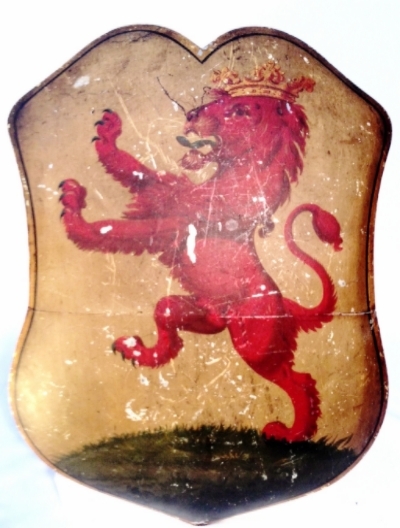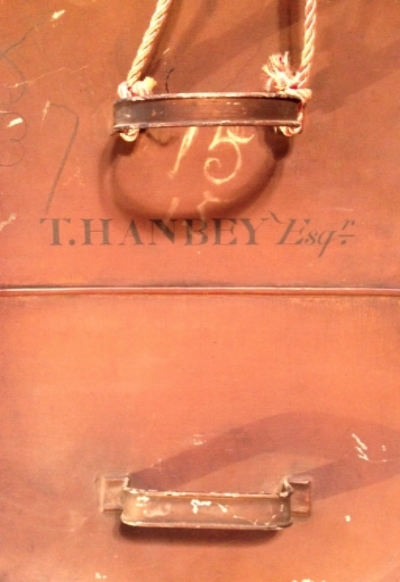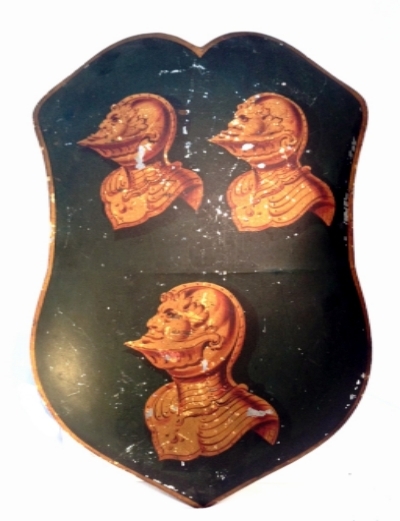| Author |
Message |
|
RD Brewer
|
 Posted: Thu 14 Jan, 2016 1:33 pm Post subject: help with shield type Posted: Thu 14 Jan, 2016 1:33 pm Post subject: help with shield type |
 |
|
Can you tell me what kind of shield this is? I thought it was just a decorative wall hanger, but it has an argive style grip on the back along with what is presumably an owner's name, followed by "Esq." It's 24" tall, 16" wide, 4.5" deep (it's curved). It's light and aluminum. It's a hand-painted antique.
My theory is it's an antique practice shield for some type of fencing club or class, but that's very speculative. It's just that the fact it has a name (as does another one I own) reminds me of what one might do in a school or at a club: have their name on their property. The other shield has its own nicely painted design.
 Attachment: 182.58 KB Attachment: 182.58 KB

 Attachment: 142.39 KB Attachment: 142.39 KB

|
|
  |
 |
Alexander Ehlers

|
 Posted: Tue 19 Jan, 2016 3:25 am Post subject: Posted: Tue 19 Jan, 2016 3:25 am Post subject: |
 |
|
Interesting shield. It certainly does remind me of something being hung on a 17th Century castle wall.
That raises a question, what century is that shield from? I don't know much about fonts, but that font looks too modern to be something from the 17th century, it's just me. I don't know much about fonts.
Call me delusional if I'm completely wrong, but the ground the Lion is walking on is round. People, to my knowledge, really only started to accept the world was round until the around the 18th century, though educated people way before knew as well. Unless the Lion is walking on a hill.
These are just my guesses. I don't know much about shields at all, but this could've been some 19th Century practice piece.[/i][/u]
Never give up without giving a fight, fighting is an opportunity for victory.
|
|
   |
 |
David Cooper

|
 Posted: Tue 19 Jan, 2016 8:26 am Post subject: Posted: Tue 19 Jan, 2016 8:26 am Post subject: |
 |
|
If the shield is aluminium remember that this was not produced as a refined metal until 1825 and was hugely expensive up until the late 1880s-1890s. It might be something prepared for successors to the The Eglinton Tournament of 1839, I believe one was held in 1912. More likely a decorative piece or one intended for mounting in a church or municipal building. Perhaps then amended for theatrical or mock tournament use.
The journey not the destination
|
|
  |
 |
|
Herbert Schmidt
|
 Posted: Tue 19 Jan, 2016 8:46 am Post subject: Posted: Tue 19 Jan, 2016 8:46 am Post subject: |
 |
|
I would say it is rather modern due to the handles and the way they are constructed. I would not say it is older than mid-nineteenth century. But that is just a guess.
| Alexander Ehlers wrote: |
Call me delusional if I'm completely wrong, but the ground the Lion is walking on is round. People, to my knowledge, really only started to accept the world was round until the around the 18th century, though educated people way before knew as well. [/i][/u] |
People in the middle ages knew perfectly well that the world was round as did people in the classical ages. They even had a pretty good idea as to the circumference which was astonishingly close to the real value.
It is a common misconception to think that there was ever a time (at least after the early antiquity) when people thought the earth to be flat.
www.arsgladii.at
Historical European Martial Arts
|
|
   |
 |
|
Mark Griffin
Location: The Welsh Marches, in the hills above Newtown, Powys. Joined: 28 Dec 2006
Posts: 802
|
 Posted: Tue 19 Jan, 2016 11:08 am Post subject: Posted: Tue 19 Jan, 2016 11:08 am Post subject: |
 |
|
Very nice indeed.
Looks like an armorial made for any number of reasons. Decorative hanger, to be carried in a pageant, something for a club wall all sorts. That R.Mount wished to be called esq probably puts it into the post 1770's gothic resurgance. There were a great many tournaments held post Eglington right up to the first world war, esp those at Cremorne Gardens and Earls Court. pretty much along the same lines, nobility and those with an interest in arms and armour getting a chance to tilt in real and repro armour of varying quality. Stylistically I'd put it early to mid 19th cent, others may differ.
Currently working on projects ranging from Elizabethan pageants to a WW1 Tank, Victorian fairgrounds 1066 events and more. Oh and we joust loads!.. We run over 250 events for English Heritage each year plus many others for Historic Royal Palaces, Historic Scotland, the National Trust and more. If you live in the UK and are interested in working for us just drop us a line with a cv.
|
|
  |
 |
David Cooper

|
 Posted: Tue 19 Jan, 2016 12:01 pm Post subject: Posted: Tue 19 Jan, 2016 12:01 pm Post subject: |
 |
|
I certainly think it can be no earlier than 1890. I may have fooled some of you with my English spelling of aluminium rather than the American aluminum 
Here is a quote from Wikipedia (I know, not always reliable but I think correct in this case )
'' In the mid-1880s, aluminium metal was exceedingly difficult to produce, which made pure aluminium more valuable than gold. So celebrated was the metal that bars of aluminium were exhibited at the Exposition Universelle of 1855. Napoleon III of France is reputed to have held a banquet where the most honoured guests were given aluminium utensils, while the others made do with gold.''
The journey not the destination
|
|
  |
 |
|
Ralph Grinly
|
 Posted: Tue 19 Jan, 2016 4:56 pm Post subject: Posted: Tue 19 Jan, 2016 4:56 pm Post subject: |
 |
|
I guess early 20th Century. Any earlier, and aluminium plate of this size was rather too expensive for such decorative items. I'm guessing it's some sort of theatrical prop. As far as the R. Mount, esq. goes..who knows ? 
|
|
  |
 |
|
Ralph Grinly
|
 Posted: Tue 19 Jan, 2016 4:57 pm Post subject: Posted: Tue 19 Jan, 2016 4:57 pm Post subject: |
 |
|
I guess early 20th Century. Any earlier, and aluminium plate of this size was rather too expensive for such decorative items. I'm guessing it's some sort of theatrical prop. As far as the R. Mount, esq. goes..who knows ? 
Anyone know if the shield is shaped in any way, or is it just a simple flat plate ? It's a bit hard to judge from the photos, but it appears to me that it may be slightly dished ?
|
|
  |
 |
|
RD Brewer
|
 Posted: Sat 30 Jan, 2016 2:03 pm Post subject: Posted: Sat 30 Jan, 2016 2:03 pm Post subject: |
 |
|
The shield is curved or dished quite a bit, several inches.
The grips are vertical on the back, meaning that the picture would be sideways if held with your elbow bent.
I could ask the owner if a magnet will stick to it.
Here is another one.
 Attachment: 140.85 KB Attachment: 140.85 KB

 Attachment: 110.36 KB Attachment: 110.36 KB

|
|
  |
 |
|
RD Brewer
|
 Posted: Sat 06 Feb, 2016 12:41 pm Post subject: Posted: Sat 06 Feb, 2016 12:41 pm Post subject: |
 |
|
I contacted the owner and asked if a magnet would stick to them. He said he would check when he gets a chance, maybe within a few weeks.
Has anyone seen a shield with a vertical grip that would show the picture on the front sideways when the elbow is bent?
Also, they look like they would be comfortable and about the right size if held when mounted. They're two feet tall and 16" wide. I wonder if that was their purpose.
|
|
  |
 |
|
Mark Griffin
Location: The Welsh Marches, in the hills above Newtown, Powys. Joined: 28 Dec 2006
Posts: 802
|
 Posted: Sat 06 Feb, 2016 2:29 pm Post subject: Posted: Sat 06 Feb, 2016 2:29 pm Post subject: |
 |
|
Both examples are too well executed to be theatrical and the style of painting wrong for early 20th cent.
I'd be very surprised if they are not armorials from a members hall of some type, either a college or more likely a livery company. A Thomas Hanbey was an Ironmonger and member of the Cutlers Company , died in 1782. He left £8,000 to various charitable causes, a huge sum for then, and 5 of it went to a school for poor boys operated by the Cutlers. He's a reasonable candidate although I'm not saying its definitely him and i can't trace his heraldry as yet, but this type of memorial to benefactors are very popular.
I work in many livery companies, town halls and fraternity buildings etc and their usage is pretty common. The strap at the back would have got over a hook or post, its not meant to be worn or carried.
Currently working on projects ranging from Elizabethan pageants to a WW1 Tank, Victorian fairgrounds 1066 events and more. Oh and we joust loads!.. We run over 250 events for English Heritage each year plus many others for Historic Royal Palaces, Historic Scotland, the National Trust and more. If you live in the UK and are interested in working for us just drop us a line with a cv.
|
|
  |
 |
|
Lafayette C Curtis
|
 Posted: Sat 27 Feb, 2016 11:13 am Post subject: Posted: Sat 27 Feb, 2016 11:13 am Post subject: |
 |
|
| Herbert Schmidt wrote: | | Alexander Ehlers wrote: |
Call me delusional if I'm completely wrong, but the ground the Lion is walking on is round. People, to my knowledge, really only started to accept the world was round until the around the 18th century, though educated people way before knew as well. [/i][/u] |
People in the middle ages knew perfectly well that the world was round as did people in the classical ages. They even had a pretty good idea as to the circumference which was astonishingly close to the real value.
It is a common misconception to think that there was ever a time (at least after the early antiquity) when people thought the earth to be flat. |
Actually it's not that simple. Educated people had known for a long time that the world was round. But the average peasant or day labourer might not have known, and might not have needed to know -- a flat plane was (and still is) a sufficiently good approximation of the Earth's curvature over the kind of distances that people would have been able to travel on foot. After all, the topographic maps we use today are flat rather than curved to match the terrain they depict!
In short, the knowledge that the Earth is round back then would probably be more comparable to the knowledge about the size and shape of the observable universe today -- the average blue-collar worker on the street doesn't need to know that just to be able to live in a functional manner.
On the other hand, of course, a sizable proportion of the European nobility was probably educated enough to know that the Earth was round by the time heraldry became popular, and even the ones who believed it was flat might simply be showing a leopard striding atop a hill. Reading too much into the precise meaning highly-stylised heraldic depictions is truly the road to madness.
|
|
  |
 |
|
|

